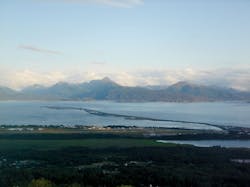Healthier Disinfection in Homer
Homer, Alaska, replaced its obsolete pressure sand filtration water treatment plant with a new robust submerged membrane. Total trihalomethanes (THHM) and haloacetic acids (HAA5) had been high in the city’s long and dead-end distribution system, but with the new water plant’s enhanced alum chemical feed and three-stage flocculation basins, it was highly anticipated that these high disinfection byproduct (DBP) levels would be significantly reduced.
The first series of testing for THHMs and HAA5s after the plant was commissioned showed marginal improvement over the preconstruction levels; however, the levels were anticipated to continue decreasing once the system had stabilized from the construction project and the old water was displaced by new water from the membrane treatment plant.
Still, DBP levels in the system continued to increase. HAA5s measured 73 in June 2009; THHMs reached levels of 100 in September 2010. In March 2011, THHMs reached 66 and HAA5s reached 46.
The elevated THHM reading in September was not unusual, as in previous years DBPs had been elevated in the fall after the peak algae season. What was disconcerting about these numbers was that the new water treatment plant processes and sophisticated submerged membranes did not appear to significantly reduce the DBPs.
Conducting an Investigation
In light of this troubling data, an approach was developed to systematically determine which treatment unit was the primary removal mechanism for total organic carbon (TOC) and at what point in the system the DBPs became a significant concern.
As expected, the new flocculation basins and membranes removed a majority of the TOCs. It became apparent that the raw water was highly reactive, as significant DBP formation occurred after the chlorine contact tank, and even higher levels occurred after the 1-million-gal tank. Prior to the chlorine contact tank, DBPs ranged from non-detects to less than 8, but after the 1-million-gal reservoir, they approached 40. This confirmed previous studies where 54% and 35% of the seven-day TTHM and HAA5 formation occurred within 30 minutes of chlorination.
TOCs from the raw water reservoir varied from 2.8 to 3.96 mg/L. TOCs prior to the chlorine contact tank varied from 1.27 mg/L to a high of 2.02 mg/L. The investigation revealed that the membrane cleaning water that was recycled to the rapid mix chamber after settling in the two-stage decant lagoon system had TOC levels in excess of 4.3 mg/L, THHMs greater than 26 and a detectable chlorine level. This decant water was therefore a contributor to the increased DBP levels of the finish water.
Seeking Solutions
During the study, additional testing was performed to determine the optimum alum dose at the rapid mix tank to obtain a floc. The alum dose was increased, which resulted in a floc formation that later was removed by the membranes.
Regular hydrant flushing improves water quality by removing minerals that have collected in the water mains. In Homer, there is another important reason for flushing water mains: The city is required to maintain trace residual chlorine in the water to ensure that it is protected from contamination by pathogens once it leaves the treatment plant. Over time, chlorine breaks down. Due to the low number of customers per mile of water main, water can be stored within the system longer than the residual chlorine lasts. By flushing or bleeding water out of the system—especially off dead-end lines—safe, pathogen-free drinking water is maintained through the distribution system.
Reducing DBPs
Periodic jar testing and visual observation of the floc in the flocculation basins has resulted in lower TOC levels, which have reduced the initial chlorine dose, thereby lowering the potential for DBPs.
Significant reductions in the DBPs have been made in the Homer water system during the past year.
Download: Here
